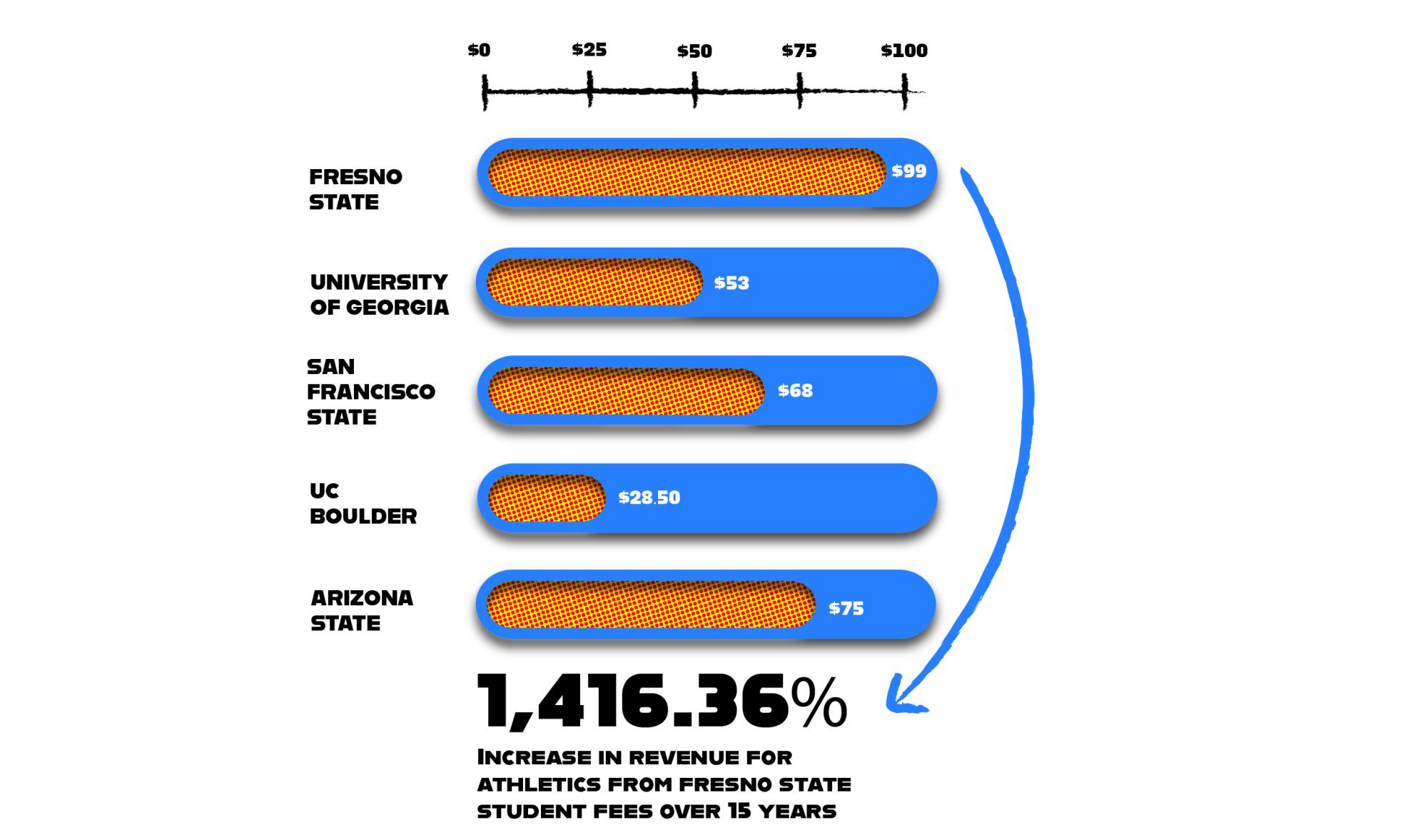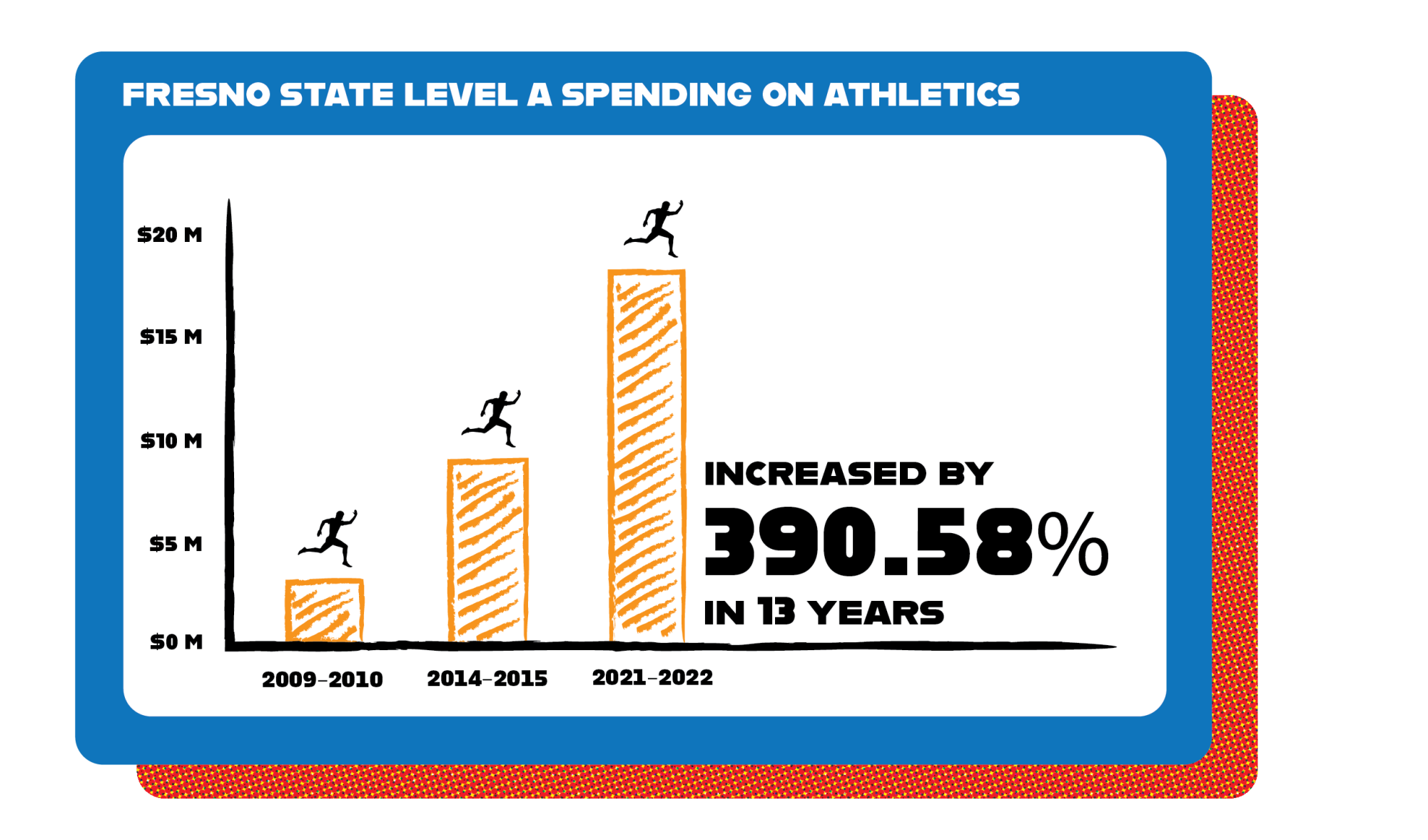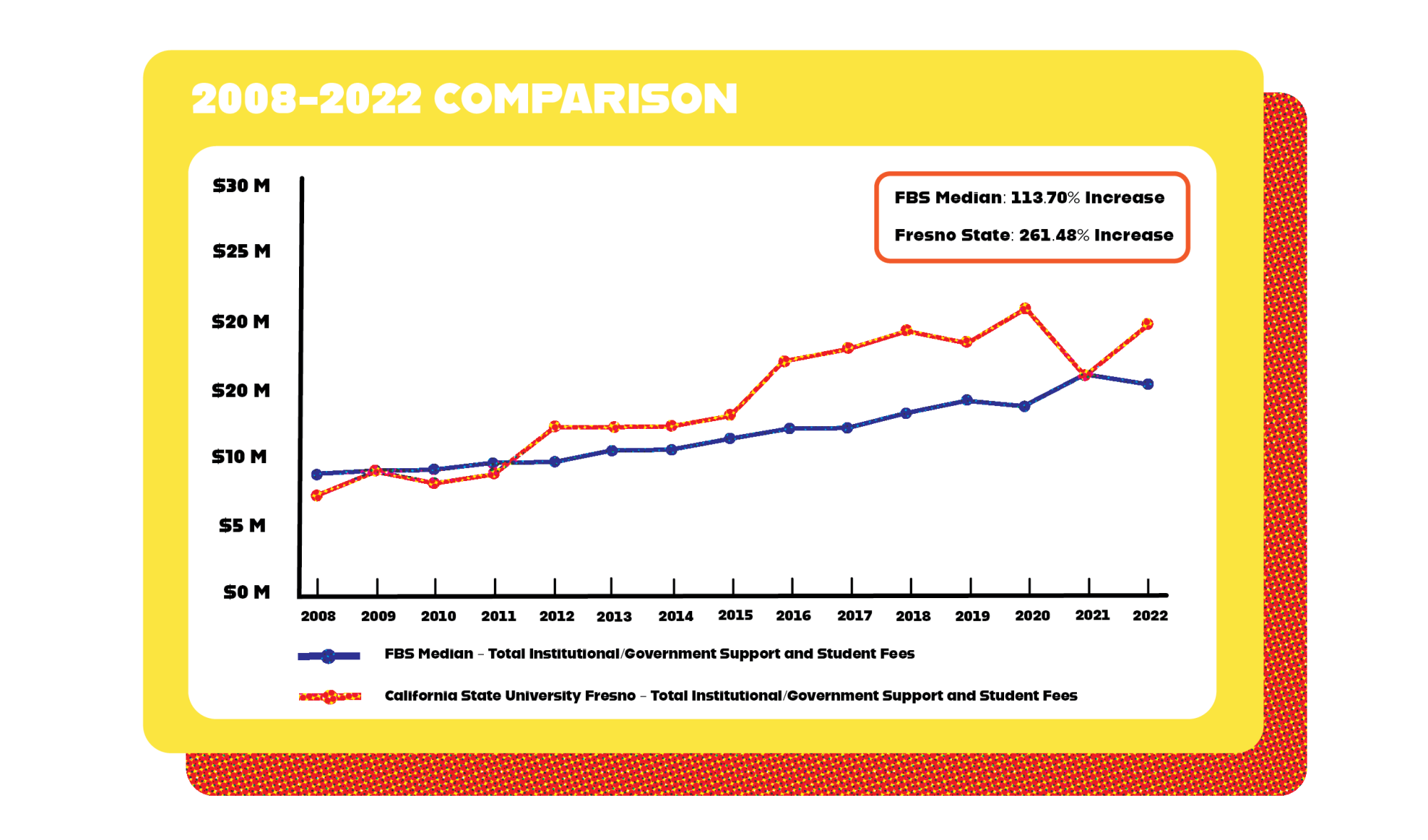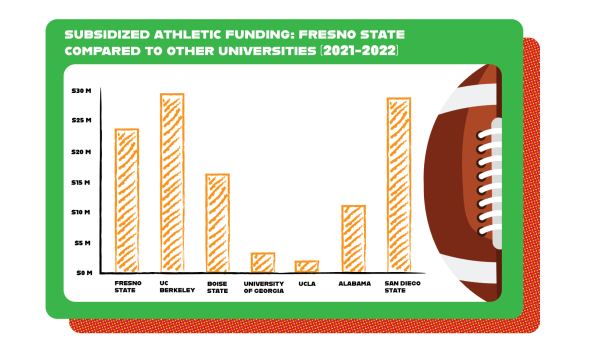Fresno State’s spending on athletics using student and taxpayer-subsidized funds has more than tripled in 15 years. This upward trajectory is raising costs for students and affecting funds for other university operations at Fresno State, according to a Collegian investigation.
Over the past several months, The Collegian gathered details on the university’s spending from 2007-08 to the 2021-22 academic year. Information about the university’s spending for athletics and other departments was gathered from the institution’s public documents and financial reports from the National Collegiate Athletic Association (NCAA).
There are three major ways to track this trend:
• Through student fees. The revenue Fresno State Athletics gets from student fees has skyrocketed within a decade and a half, increasing from $288,506 in the 2007-08 fiscal year to $4.3 million in 2021-22. That’s a 1,416% increase, the largest percentage increase for athletic student fee revenue of any Division l public university in the nation compared to other institutions.
• Through tuition and state funding. The Fresno State athletics department’s allocation from the general fund, which is composed of revenue from the state of California and student tuition fees, rose by 390% in 13 years, increasing from $3.6 million in 2009-10 to $18.1 million in 2021-22.
• Through tuition reserve funds. Fresno State is spending more money on athletics than any other category from its ‘tuition reserve’ funds, the only unrestricted source of funding for annual campuswide operational needs. Fresno State budgeted approximately $5.3 million from its tuition reserves to spend on athletics for the 2022-23 academic year, while $730,000 was budgeted for academic affairs.
Data on Fresno State’s athletic spending and revenue sources was also collected using the Knight-Newhouse College Athletics Database, which consists of data compiled by USA Today and Syracuse University’s Newhouse School of Public Communications to track the college athletics finances of 230 public institutions participating in NCAA Division l athletics.
Increased spending for athletics and how much students pay represents a realignment of Fresno State’s priorities in the last decade and a half. Even though the information is available from public documents, there is little discussion about this financial shift, which has been underreported.
Jeffrey Cummins, a political science professor at Fresno State, served on the University Budget Committee from 2016-19. He says general fund allocations have risen to ensure Fresno State’s intercollegiate sports programs are on par with rival universities such as San Diego State and Boise State.
“Fresno State is trying to keep up competitively with these other schools. Since they’re not a Power Five conference [school] they don’t get a ton of revenues from the league that they’re in. So the university has decided that in order to try and keep up competitively within the Mountain West they need to allocate more funding towards the athletics program,” Cummins said.
Debbie Adishian-Astone, Fresno State’s vice president of administration and chief financial officer, says funding athletics is crucial since it’s a way for the university to market itself.
“It’s a front door into the campus,” Adishian-Astone said. “Some students come to Fresno State because of athletics not because of being a student-athlete, but they want to have that experience as part of their campus experience. It’s a recognizable brand and it helps to promote the university, both nationally and internationally.”
Fresno State President Saúl Jiménez-Sandoval said a successful intercollegiate athletics program is vital not only to the campus but to the Central Valley.
“The success of our athletics programs enhances the visibility and reputation of Fresno State, attracting prospective students, donors, and partnerships that contribute to the economic vitality of the Central Valley region,” Jiménez-Sandoval said.
Increased student fee revenue
Students fund athletics directly through the student fees they pay. A portion of the student fees that go to Fresno State Athletics comes from the Instructionally Related Activities (IRA) fee, which students currently pay $132 per semester.
According to the IRA guidelines, $92 of that fee is allocated to intercollegiate athletics. The remainder of the fee allocates $30 for IRA projects and $10 for academic programs.
Funds from the IRA fee support programs and projects that provide students with experiences outside of class that can relate to their field of study and improve their learning experience. This includes drama performances, musical productions, art exhibits, clubs and guest speakers.
The IRA fee also funds learning workshops and student travel to attend regional and national conferences.
“Instructionally Related Activities is a program where clubs, recognized cultural organizations or faculty are able to apply for funds to enhance the student experience,” said Karen Carrillo, Fresno State’s Associated Students Inc. president. “If you’re trying to bring in a speaker for students to learn from them or hear from them, IRA can cover that.”
The student body fee, which costs students $34.50 per semester, as stated on page 8 of the 2017-18 Fresno State Athletics budget document, includes $7 for athletic funding. (Full disclosure: The Collegian receives IRA funding for conferences and money from the student body fee to finance its publication and that of its sister ethnic student newspapers.)
Total student fees, then, add up to $99 per semester to fund intercollegiate athletics. This is more than what is charged by some sports powerhouse schools like the University of Georgia, which charges its students a $53 athletic fee each semester.

Jiménez-Sandoval said Fresno State is one of the most affordable campuses in the California State University (CSU) system when it comes to fees.
“Fresno State has consistently focused on keeping student fees affordable,” Jiménez-Sandoval said. “We currently have the third-lowest campus-based fees in the entire CSU system.”
However, Fresno State’s fees, particularly the IRA fee, were lower a decade and a half ago than they are now.
Athletics received no funding from IRA before the 2008-09 fiscal year, but that changed when then Fresno State President John D. Welty approved a proposal from the Campus Fee Advisory Committee to raise the fee by $52 in May 2008 after students voted to reject a referendum that would have increased the fee by $72. This increased the IRA fee from $10 to $62 per semester, with $32 of it allocated to Fresno State Athletics.
The fee increased again for the 2011-12 academic year, this time by $70, from $62 to the current rate of $132 per semester.
The IRA guidelines say the students paying the fee should be the beneficiaries.
But with most of the IRA funds going to athletics, the number of students who benefit from the fee is a minority since there’s less money available to support other out-of-class experiences.
The $132 IRA fee is not upsetting to Adam Leon, a junior at Fresno State and president of the Fresno State Science Fiction Club, but he believes the fee should be more evenly distributed.
“Fresno State has a priority of who gets the favorites of the funding, and it’s just not us,” Leon said. “So it’s one of those things where, would more funding get us more money? Most likely because we do get a percentage, but it’s also one of those things where there should probably be more equality behind it.”
Fresno State has approximately 430 students who participate in intercollegiate athletics, which accounts for less than 2% of the total student population on a campus of almost 24,000.
Spending with public money
Fresno State Athletics operates as an auxiliary enterprise. This means that it is a self-supporting nonprofit entity that offers services on behalf of the university, but runs its operations independently. Athletics generates its own revenue from sources such as donations, ticket sales, media rights and corporate sponsorship.
However, it still receives financial support from the university’s general fund to help cover all its costs.
Most universities don’t make money from their college athletics programs. More than 320 Division l athletic programs needed subsidies (i.e., institutional/government support and student fees) to help cover expenses. Only 28 schools generated a profit from college sports in 2022, according to an NCAA Division I Revenue and Expenses Report published in December 2023.
Fresno State needs to spend more from its general fund to ensure the athletics department isn’t overwhelmed by costs.
During his time on the University Budget Committee, Cummins noticed a consistent pattern with athletics funding.
“They were spending more money than they were being allocated and the university would fill in that gap with money from other places, including academics,” Cummins said.
Fresno State Athletics gets part of its budgeted funds directly from the campus operating budget. The athletic department’s total revenue during the 2021-22 academic year was $54.12 million, with $18.8 million coming from institutional/government support.
The CSU allocates funds to all 23 campuses in the system, which includes Fresno State.
Funds from the state of California and the systemwide tuition fee are the CSU system’s two primary sources of revenue. These funds go into Fresno State’s campus operational fund, which can be allocated to the athletics department, meaning students indirectly pay more for athletics apart from their student fees.
Tuition revenues and state money received from the CSU system are classified as Level A allocation at Fresno State. This general fund of the institution is subsequently dispensed to the institution’s various divisions, including academic affairs, student affairs, athletics and technology services.
Academic affairs get most of the allocations, making up nearly 70% of the money that goes to all of Fresno State’s divisions.
The athletics department’s revenue from Fresno State’s Level A allocations rose by 390% in 13 years, increasing from $3.6 million in 2009-10 to $18.1 million in 2021-22.

Adishian-Astone said the increase in funding for athletics is because costs in general are rising.
“There are lots of reasons: You have operating costs that go up, salaries and wages and benefit costs that go up,” Adishian-Astone said. “There’s just mandatory costs that increase over the years. I don’t think there’s one particular reason. As all budgets do, they do increase over time.”
However, funding for athletics at Fresno State has risen at a faster rate than many other universities.
From 2007-08 to 2021-22, subsidized funding for Fresno State Athletics increased by 261%, the second-highest percentage increase among Division l public universities in California after the University of California, Berkeley.

Subsidized funds comprised 43% of Fresno State Athletics’ total revenue during the 2021-22 fiscal year.
Fresno State budgeted approximately $5.3 million from its tuition reserves to spend on athletics for the 2022-23 academic year, according to page 8 of the 2022-23 budget presentation.
Pam Lewis, Fresno State’s budget and resource planning manager, wrote in an email response to a Collegian query that funds in the reserve are not exclusively composed of student tuition.
“The tuition reserve is the only unrestricted reserve for uncertainties that funds annual campuswide operational funds,” Lewis said. “It is not funded strictly with tuition and fee revenues.”
These funds can be allocated to anything, including athletics and deferred maintenance.
Fresno State budgeted $571,432 from the reserve fund to help pay for two loans used for upgrades to Valley Children’s Stadium. These loans – which will be paid back to the CSU chancellor’s office and the university’s Division of Continuing and Global Education – are for electrical infrastructure and the field turf, Adishian-Astone said.
The reserve holds funding from multiple sources, but may also include federal funds from the U.S. Department of Education and the Higher Education Emergency Relief Fund (money allocated for COVID-19 situations) along with money from the systemwide tuition fee paid by students, said Susan Henderson, an associate professor and chair of the Department of Accountancy, in an email to The Collegian.
Fresno State’s budget and resource planning manager, vice president of administration and the university president decide the spending of these funds.
“Ultimately, the budget manager, Pam Lewis, and myself if there are needs that are unforeseen during the year, we have those discussions and ultimately the president approves any recommendation that we may make,” Adishian-Astone said.
The purpose of the tuition reserve is to have funds available for unforeseen costs. In other words, it’s money the university uses to cover financial shortfalls.
“Organizations will set aside money just like we do in our daily lives,” said Fernando Parra, an accounting professor at Fresno State. “We have some savings that we call it savings for a rainy day that will help us in case we’re not able to go to work and are out of sick leave, or you have an emergency that requires you to depart from the budgetary plan that you have for a family. So in an organization, this works very similar.”
General fund allocations to athletics could rise further after the CSU approved a proposal to raise tuition in September 2023, as this will increase Fresno State’s Level A funding.
Twelve years before raising tuition in 2023, the CSU approved a 12% tuition hike in July 2011, which took effect that same year. Level A allocations to Fresno State Athletics more than doubled seven years after the hike, growing from $7.5 million in 2011-12 to $16.1 million in 2017-18.

More subsidized funds would also go to Fresno State Athletics if Measure E passes. The measure seeks to approve a one-cent sales tax for every $4 spent in Fresno County, which would generate an estimated $1.5 billion for Fresno State over 25 years, including $240 million that would go to fund athletics projects, according to the Measure E project list.
The impact of Measure E might even go beyond Fresno County because other communities could see it as an example to fund other universities in California.
“I think we’ve seen this historically in California when certain jurisdictions are successful in passing a tax measure that other areas look to it as a potential source of funding, so it can definitely set a precedent,” Cummins said.
How subsidized athletic spending could affect students and staffing
While increased spending on intercollegiate sports is not the only reason college has gotten more expensive, higher athletic fees are among several factors that add to the cost of attendance.
More students are having to find ways to balance their time between school and work to sustain themselves economically.
Students on campus are known to struggle with balancing their time between school and work in order to sustain themselves economically, Carrillo said.
Some clubs at Fresno State cope with limited IRA funding.
Leon said being a part of student organizations and participating in extracurricular activities is an important part of being in college.
That has proven to be a challenge for him because he’s had to pay out of pocket to fund the science fiction club due to minimal financial support from the IRA program.
“I’ve personally put about $3,000 of my own money to help start this club. The reason why I’m doing this is because I want to make connections and I want other people to make connections,” Leon said. “The best way to have good experiences is by joining clubs and having these events, activities and conferences. The problem is there’s so little funding from IRA.”
Aman Singh, a junior at Fresno State, said he isn’t bothered by the fact that $92 of the IRA fee he pays goes to athletics because he supports intercollegiate sports.
However, Singh does think the university could use more funds for services like tech lending.
He recalled not being able to borrow a laptop when his own got damaged midway through a semester due to a lack of availability.
“I reached out to the library tech department and they couldn’t provide me with a single laptop,” Singh said. “So I have to literally wait for like two weeks, and then I got nothing back. I reached out to them and they’re like, ‘unfortunately we don’t have enough laptops.’ That is so crazy because I’m paying a crazy amount of money, and you cannot even provide me with one laptop.”
It could also mean other divisions on campus may have less funding to support their programs and departments.
The funds from Fresno State’s Level A allocations to athletics are the same funds that could be used for academic purposes.
“It’s true that if you’re spending money on athletics, that is taking away money from other divisions. That’s the zero-sum part of budgeting,” Cummins said. “If you were to take money away from athletics and put that into academic affairs, you could hire more faculty to teach more classes.”
Fresno State Athletics’ total spending during the 2021-22 academic year was $46.52 million, with $10.62 million going to coaches’ compensation, including bonuses and stipends.
Intercollegiate athletics coaches have the highest compensation in the university.
“That’s the market in athletics and Division l programs,” Adishian-Astone said. “If you look at our peer institutions, they’re dealing with the same kind of comparability as far as coaches’ salaries as we are. We are not unique.”
Fresno State football head coach Jeff Tedford signed a five-year contract in December 2021 that averages $1.65 million per year plus bonuses. Fresno State men’s basketball head coach Justin Hutson and women’s basketball head coach Jaime White received $654,956.08 and $291,008, respectively, in total compensation during the 2022-23 fiscal year, according to a document obtained by The Collegian from a Freedom of Information Act request.
“It’s just accepted. I mean, there’s not a lot of protest about it,” Cummins said. “It’s accepted that coaches are going to be paid a lot more than faculty. That doesn’t make it fair, but that’s what it seems to be, and that is probably because society values college sports more than they do academics.”
Lack of transparency
Fresno State doesn’t make it easy for students to know how much they are paying to fund its sports programs, as there is no athletic fee that appears on their total tuition and fees bill.
Adishian-Astone said Fresno State is transparent when it comes to student fee funding.
“We’ve always provided it whenever asked either by student leaders or this kind of interview, and everything is transparent and we document where all the fees go,” she said.
However, other institutions such as San Francisco State, the University of Colorado Boulder and Arizona State show students an athletic fee on their respective tuition and fee web pages.
Fresno State’s tuition and fees web page says funding for athletics comes from the student body and IRA fees, but doesn’t specify an amount.
Students who want to know how much of their fees goes to athletics need to search in university documents, which can often be challenging.
“I guess there should be some level of transparency so that there’s some level of awareness among students because I want to know what I’m paying for,” Singh said.
Lisa Bryant, a political science professor at Fresno State, said letting students know where their money is going is a way for the university to gain their trust.
“I think students should know what fees are being charged,” Bryant said. “Transparency can help instill confidence that funds are being used and managed appropriately.”
Leon is not completely opposed to the idea of higher student fees and even supports increasing them to support student organizations.
His only condition is that everyone on campus should be able to know how the funds are being used.
“I’m in favor of more transparency and even new rules that separate the fees where they’re going specifically and raising fees for clubs because we just get nothing,” Leon added.
Singh thinks more students would be proactive about the fees they pay if they knew where their money is going.
“We don’t care because we’re not aware,” Singh said. “We were not even aware that we’re paying this amount of money to athletics.”
This story was originally published on The Collegian on February 28, 2024.





































